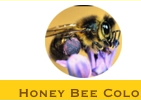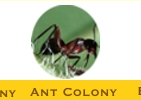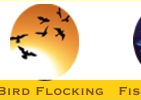 |
 |
 |
 |
 |
 |
 |
 |
 |
 |
 |
|
|
 |
 |
 |
 |
 |
 |
 |
| |
Artificial Bee Colony (ABC) Algorithm 20th Anniversary Workshop
20. Yılında Yapay Arı Koloni (ABC) Algoritması Çalıştayı
Artificial Bee Colony (ABC)
Algorithm
|
Self-organization and division of labour are necessary and sufficient properties to obtain swarm intelligent behaviour (Bonabeau, Dorigo and Theraulaz, Swarm Intelligence: From Natural to Artificial Systems, Oxford University Press, 1999). Four basic properties on which self organization relies are positive feedback, negative feedback, fluctuations and multiple interactions. When the behaviour of honey bees is examined carefully (Seeley, The Wisdom of The Hive, Harvard University Press, 1995), it is seen that these four properties are inherent in foraging honey bees: i) Positive feedback: As the nectar amount of food sources increases, the number of onlookers visiting them increases, too; ii) Negative feedback: As the nectar amount of food sources decreases, their employed bees’ dance duration decreases and finally recruiting is stopped; iii) Fluctuations: The scouts carry out a random search process for discovering new rich food sources; iv) Multiple interactions: Bees share their information about the food sources with their nest mates via dances on the dance area.
Artificial Bee Colony (ABC) is one of the most recently defined algorithms by Dervis Karaboga in 2005, motivated by the intelligent behavior of honey bees. It is as simple as Particle Swarm Optimization (PSO) and Differential Evolution (DE) algorithms, and uses only common control parameters such as colony size and maximum cycle number. ABC as an optimization tool, provides a population-based search procedure in which individuals called foods positions are modified by the artificial bees with time and the bee’s aim is to discover the places of food sources with high nectar amount and finally the one with the highest nectar. In ABC system, artificial bees fly around in a multidimensional search space and some (employed and onlooker bees) choose food sources depending on the experience of themselves and their nest mates, and adjust their positions. Some (scouts) fly and choose the food sources randomly without using experience. If the nectar amount of a new source is higher than that of the previous one in their memory, they memorize the new position and forget the previous one. Thus, ABC system combines local search methods, carried out by employed and onlooker bees, with global search methods, managed by employed bees and scouts, attempting to balance exploitation and exploration processes. A good analogy exists between the intelligent foraging behaviour of honey bees and the intelligent optimization process performed by ABC algorithm as in the table:
| Analogy |
| Real foraging honey bee colony |
Artificial bee colony-ABC (Optimization) |
| Working in continuous time |
Discrete time |
| Having memory |
Memory |
| Maximizing the honey inside a hive |
Max/Minimizing objective function(s) for a problem |
| Accessible food sources around a hive |
Possible solutions for an optimization problem |
| Number of accessible food sources around a hive |
Population size of possible solutions in a search space |
| Nectar amount (profitability) of a food source |
Fitness (quality) of a solution to the optimization problem |
| Five-dimensional search space |
n-dimensional search space |
| Employed bees |
Local-global search ability using her memory |
| Onlooker bees-positive feedback |
Enhancing local search ability in the vicinity of possible good solutions |
| Scout bees-fluctations |
Enhancing global search ability by the abondonment mechanism and random search |
Multiple interactions:
i) Dance based
ii)Pheromone based |
Dance based interaction |
| Adaptation to new conditions in the hive and changes in the environment |
Balance between exploration and exploitation based on “limit” parameter |
Since 2005, some members of the intelligent systems research group,
the head of the group is
D.Karaboga, have studied on ABC algorithm
and its applications to real world-problems.
Karaboga and
Basturk
have studied on the version of ABC algorithm for unconstrained
numerical optimization problems and its extended version for the
constrained optimization problems.
Dervis Karaboga (2010) Artificial bee colony algorithm. Scholarpedia, 5(3):6915.
A review on the versions of artificial bee colony algorithm for scheduling problems
A survey on the Artificial Bee Colony algorithm variants for binary, integer and mixed integer programming problems
A review on the studies employing artificial bee colony algorithm to solve combinatorial optimization problems
A survey on the studies employing machine learning (ML) for enhancing artificial bee colony (ABC) optimization algorithm
Rust code of the Artificial Bee Colony (ABC) algorithm has been released (24.10.2024).
Python code of the basic Artificial Bee Colony algorithm has been released (27.05.2020).
C# code of the Artificial Bee Colony Programming (ABCP) has been released (10.09.2019).
Two new improved implemantation codes of ABC have been published in Information Sciences: M. Mernik, SH. Liu, D. Karaboga, M. Crepinsek, "On clarifying misconceptions when comparing variants of the Artificial Bee Colony Algorithm by offering a new implementation", Information Sciences, DOI: 10.1016/j.ins.2014.08.040.
An implementation of the Artificial Bee Colony (ABC) Algorithm (R-package, A new version).
A version of ABC algorithm in CRAN (The Comprehensive R Archive) by George G. Vega Yon (Pure R code).
A demo program of Artificial Bee Colony Programming -ABCP-
Artificial Bee Colony Programming -ABCP- for Symbolic Regression
A Special Session on Artificial Bee Colony Algorithm in CEC 2012
ABC Algorithm Source Code by Delphi for Constrained Optimization has been released (17.05.2011)
Step by Step Procedure of ABC Algorithm can be downloaded from
here (pdf) (16.05.2011)
Neural Network Training by ABC
algorithm, XOR Problem Example has been released (15.03.2011)
A Special Session on Artificial Bee Colony Algorithm in CEC 2011
JAVA Code of
the ABC algorithm has been released (15.04.2010)
C Code of
the ABC algorithm has been released (14.12.2009)
MATLAB Code
of the ABC algorithm version 2 has been released (14.12.2009) (more
optimized coding)
MATLAB code of the basic ABC algorithm has been released (30.12.2008). Please click for
downloading.
You can download the software
demonstrating the scatter of bees in the search space from here
(26.11.2008)
Detailed Pseudo-code of the ABC Algorithm can be downloaded from
here (pdf) (14.10.2008)
Our Visitors Statistics....:
|
|
 |
| |
 |
|
Intelligent Systems
Research Group, Department of Computer Engineering, Erciyes University,
Turkiye |
 |
 |
 |
 |
 |
 |
 |
 |
| |
 |
|